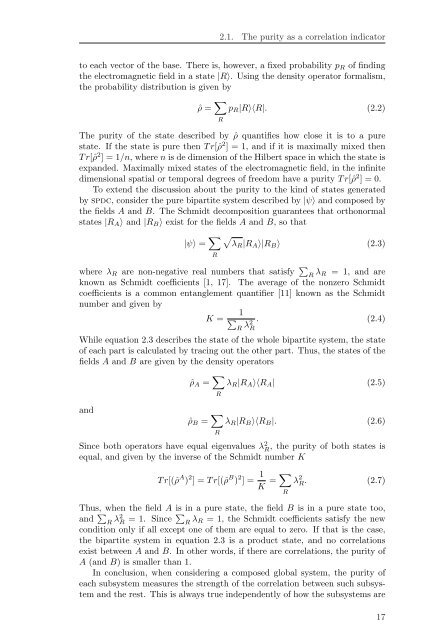Spatial Characterization Of Two-Photon States - GAP-Optique
Spatial Characterization Of Two-Photon States - GAP-Optique
Spatial Characterization Of Two-Photon States - GAP-Optique
Create successful ePaper yourself
Turn your PDF publications into a flip-book with our unique Google optimized e-Paper software.
2.1. The purity as a correlation indicator<br />
to each vector of the base. There is, however, a fixed probability pR of finding<br />
the electromagnetic field in a state |R〉. Using the density operator formalism,<br />
the probability distribution is given by<br />
ˆρ = <br />
pR|R〉〈R|. (2.2)<br />
R<br />
The purity of the state described by ˆρ quantifies how close it is to a pure<br />
state. If the state is pure then T r[ˆρ 2 ] = 1, and if it is maximally mixed then<br />
T r[ˆρ 2 ] = 1/n, where n is de dimension of the Hilbert space in which the state is<br />
expanded. Maximally mixed states of the electromagnetic field, in the infinite<br />
dimensional spatial or temporal degrees of freedom have a purity T r[ˆρ 2 ] = 0.<br />
To extend the discussion about the purity to the kind of states generated<br />
by spdc, consider the pure bipartite system described by |ψ〉 and composed by<br />
the fields A and B. The Schmidt decomposition guarantees that orthonormal<br />
states |RA〉 and |RB〉 exist for the fields A and B, so that<br />
|ψ〉 = <br />
λR|RA〉|RB〉 (2.3)<br />
R<br />
where λR are non-negative real numbers that satisfy <br />
R λR = 1, and are<br />
known as Schmidt coefficients [1, 17]. The average of the nonzero Schmidt<br />
coefficients is a common entanglement quantifier [11] known as the Schmidt<br />
number and given by<br />
K =<br />
1<br />
<br />
R λ2 R<br />
. (2.4)<br />
While equation 2.3 describes the state of the whole bipartite system, the state<br />
of each part is calculated by tracing out the other part. Thus, the states of the<br />
fields A and B are given by the density operators<br />
ˆρA = <br />
λR|RA〉〈RA| (2.5)<br />
and<br />
R<br />
ˆρB = <br />
λR|RB〉〈RB|. (2.6)<br />
R<br />
Since both operators have equal eigenvalues λ2 R , the purity of both states is<br />
equal, and given by the inverse of the Schmidt number K<br />
T r[(ˆρ A ) 2 ] = T r[(ˆρ B ) 2 ] = 1<br />
K<br />
<br />
= λ 2 R. (2.7)<br />
Thus, when the field A is in a pure state, the field B is in a pure state too,<br />
and <br />
R λ2 <br />
R = 1. Since R λR = 1, the Schmidt coefficients satisfy the new<br />
condition only if all except one of them are equal to zero. If that is the case,<br />
the bipartite system in equation 2.3 is a product state, and no correlations<br />
exist between A and B. In other words, if there are correlations, the purity of<br />
A (and B) is smaller than 1.<br />
In conclusion, when considering a composed global system, the purity of<br />
each subsystem measures the strength of the correlation between such subsystem<br />
and the rest. This is always true independently of how the subsystems are<br />
R<br />
17



